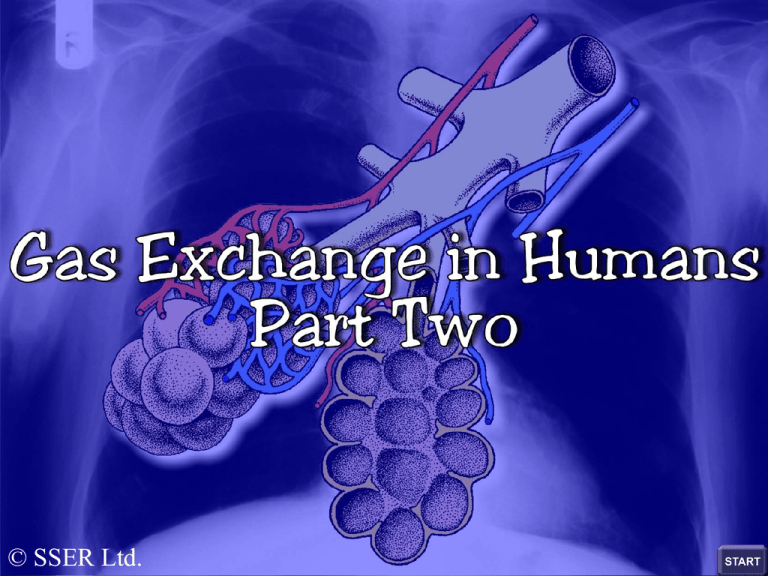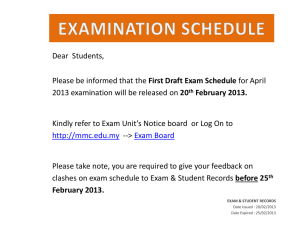
© SSER Ltd.
Control of Rhythmic Breathing
The basic breathing rhythm is a reflex action under the control of the nervous system
The region of the brain controlling this basic rhythm is the medulla oblongata
The medulla contains a
breathing centre
consisting of two groups
of nerve cells, called the
inspiratory and
expiratory centres
Nerves arising from these
centres innervate (make
contact with) the intercostal
muscles and the diaphragm
The thoracic nerves innervate
the intercostal muscles
The phrenic nerves
innervate the diaphragm
Impulses travelling
along the thoracic
and phrenic nerves
from the expiratory
centre lead to
relaxation of the
diaphragm and
intercostal muscles
EXPIRATION
FOLLOWS
The alveoli deflate
and stretch
receptors are no
longer stimulated
inhibit
stimulate
thoracic nerves
phrenic nerves
A pattern of nerve impulses
travels along the vagus nerve
to the respiratory centres
leading to inhibition of the
inspiratory centre and
stimulation of the
expiratory centre
Expiratory
centre
Inspiratory
centre
phrenic nerves
stimulate
inhibit
A pattern of nerve impulses
travels along the vagus nerve
to the respiratory centres
leading to stimulation of the
inspiratory centre and
inhibition of the expiratory
centre
INSPIRATION
FOLLOWS
thoracic
nerves
At the height of an Impulses travelling along
inspiration, the
the thoracic and phrenic
alveoli are inflated
nerves from the
and stretched,
inspiratory centre lead to
thus stimulating
contraction of the
stretch receptors
diaphragm and
in their walls
intercostal muscles
Composition of Inspired and Expired Air
The purpose of the breathing rhythm is to ventilate the lungs to allow delivery of oxygen
to the alveoli, and elimination of the waste gas carbon dioxide from the alveoli
As a consequence of gas exchange at the alveoli, there are differences between the
composition of inhaled and exhaled air
Another factor that contributes to the differences found between inspired and expired air,
is the dead space content
The dead space is the
region of the respiratory
tract where NO gas
exchange takes place
trachea
bronchi
Gas exchange only takes
place across the thin walls
of the alveoli
The air filling the trachea,
bronchi and bronchioles is
unavailable for gas
exchange and is said to
occupy dead space
A healthy adult, at rest,
inspires approximately
600 cm3 of air of which
about 150 cm3 fills the
airways
The volume of air actually
reaching the alveoli is
thus about 450 cm3
bronchioles
As the air passages are never completely emptied of air, there is only a partial
replacement of air in the lungs
Composition of Inspired and Expired Air
The table below can be used to explain what happens to air as it
enters and leaves the respiratory system
The Relative Composition (% by Volume) of
Inspired, Expired & Alveolar Air
Gas
Inspired air
%
Expired air
%
Alveolar air
%
Oxygen
20.71
14.6
13.2
Carbon
dioxide
0.04
3.8
5.0
Water
vapour
1.25
6.2
6.2
Nitrogen
78.0
75.4
75.6
It is important to realise that the lungs can never be completely emptied of air; even
following a forced expiration, air remains within the alveoli and this amount of
air is called the residual volume
Composition of Inspired and Expired Air
Inspired air contains approximately 21% by volume of oxygen gas; as this fresh air is
drawn into the alveoli, it mixes with air already present (the residual volume)
The Relative Composition (% by Volume) of
Inspired, Expired & Alveolar Air
Gas
Inspired air
%
Expired air
%
Alveolar air
%
Oxygen
20.71
14.6
13.2
Carbon
dioxide
0.04
3.8
5.0
Water
vapour
1.25
6.2
6.2
Nitrogen
78.0
75.4
75.6
The residual volume dilutes the fresh air, such that the oxygen content falls to about
67% of that in the atmosphere
The oxygen content of alveolar air now falls even further as oxygen diffuses
from the alveoli in to the blood along its concentration gradient
Composition of Inspired and Expired Air
The carbon dioxide content of alveolar air increases significantly as gas exchange
proceeds and carbon dioxide diffuses from the blood into the alveoli
The Relative Composition (% by Volume) of
Inspired, Expired & Alveolar Air
Gas
Inspired air
%
Expired air
%
Alveolar air
%
Oxygen
20.71
14.6
13.2
Carbon
dioxide
0.04
3.8
5.0
Water
vapour
1.25
6.2
6.2
Nitrogen
78.0
75.4
75.6
The oxygen content of expired air is higher than that in the alveoli and is intermediate in
value between that atmospheric air and alveolar air
This is explained by the fact that expired air from the alveoli mixes with the
dead space air whose oxygen content is the same as that of the atmosphere
Composition of Inspired and Expired Air
The percent by volume of carbon dioxide in expired air is less than that of alveolar air
The Relative Composition (% by Volume) of
Inspired, Expired & Alveolar Air
Gas
Inspired air
%
Expired air
%
Alveolar air
%
Oxygen
20.71
14.6
13.2
Carbon
dioxide
0.04
3.8
5.0
Water
vapour
1.25
6.2
6.2
Nitrogen
78.0
75.4
75.6
Again, this is explained by the fact that expired air from the alveoli mixes with the dead
space air containing very low levels of carbon dioxide
Composition of Inspired and Expired Air
The water vapour content of expired air is significantly higher than that of inspired air;
as air is breathed into the alveoli, water from the lining of the alveoli evaporates into the
alveolar air such that expired air is greater in volume than inspired air
The Relative Composition (% by Volume) of
Inspired, Expired & Alveolar Air
Gas
Inspired air
%
Expired air
%
Alveolar air
%
Oxygen
20.71
14.6
13.2
Carbon
dioxide
0.04
3.8
5.0
Water
vapour
1.25
6.2
6.2
Nitrogen
78.0
75.4
75.6
Nitrogen gas is neither used or produced by the body and actual amounts of nitrogen in
inspired an expired air do not change
The slightly larger volume of expired air means that nitrogen forms part of a
larger volume during expiration and so its percent by volume decreases
Measuring Lung Volumes
The spirometer consists of a large tank of water,
onto which rests a large, and very light
perspex lid
counter
-weight
light, perspex
lid
A series of pipes lead
from from the air under
the lid of the box to
the mouthpiece
A set of valves ensures
that inspired and
expired air travel along
different pipes
The subject breathes air
into and out of the space
under the lid via
the mouthpiece
tank of water
kymograph
A counterweight
on the edge of
the lid is used to
balance the box,
so that its edges
just rest under
the surface of
the water
A nose clip is placed on the subject
to prevent any air being lost from
the system through the nose
Volume changes associated
with breathing are recorded
with a pen from the lid onto a
rotating drum (kymograph)
mouthpiece
valves
soda lime
Expired air is
passed over soda
lime to absorb
CO2 gas thus
preventing the
subject from
inspiring
increasing
amounts of
this gas
The volumes of air inspired and expired in different circumstances, can
be measured using an instrument called a spirometer
As the subject
breathes in through
the mouthpiece,
the lid moves down
As the subject
breathes in through
the mouthpiece,
the lid moves down
As the subject
breathes out through
the mouthpiece,
the lid moves up
As the subject
breathes in through
the mouthpiece,
the lid moves down
As the subject
breathes out through
the mouthpiece,
the lid moves up
Kymograph Recording of Lung Volumes
volume in dm
3
maximal inspiration
time
This graph shows the results of a spirometer recording; it is customary
to display spirometer traces upside down with inspiration curves
moving upwards and expiration curves moving downwards
The volume of air breathed in an out during one ventilation cycle, or breath,
is called the TIDAL VOLUME
volume in dm
3
maximal inspiration
tidal volume
time
The tidal volume is found to vary from 0.4 to 0.6 dm3 in healthy subjects;
following strenuous exercise it can rise to around 3.0 dm3
The air we normally breathe in and out, does not represent our full capacity
for inspiration or for expiration
If a subject is asked to take as deep a breath as possible, i.e. force an inspiration,
we obtain a trace of the INSPIRATORY CAPACITY
maximal inspiration
inspiratory
reserve volume
volume in dm
3
inspiratory
capacity
tidal volume
time
In order to achieve their inspiratory capacity, subjects must continue to inhale after
a normal inspiration
The extra amount of air that can be inhaled following a normal inspiration
is called the INSPIRATORY RESERVE VOLUME
Subjects can also force an expiration, although the extra volume of air that can be
expired is less than obtained in a forced inspiration
maximal inspiration
inspiratory
reserve volume
volume in dm
3
inspiratory
capacity
expiratory
capacity
expiratory
reserve volume
tidal volume
time
As with inspiration, we can obtain traces for EXPIRATORY CAPACITY and
EXPIRATORY RESERVE VOLUME
If we add together the inspiratory and expiratory capacities, that is the maximum volume
of air that can be exchanged during one breath in and out, we have a measure of the
VITAL CAPACITY
maximal inspiration
volume in dm
3
inspiratory
capacity
inspiratory
reserve volume
vital
capacity
expiratory
capacity
expiratory
reserve volume
time
The average vital capacities are about 5.5 dm3
for a male and 4.25 dm3 for a female
tidal volume
The lungs cannot be completely emptied and a certain volume of air always remains
in the lungs even following a forced expiration
This is called the RESIDUAL VOLUME
maximal inspiration
volume in dm
3
inspiratory
capacity
inspiratory
reserve volume
vital
capacity
expiratory
capacity
expiratory
reserve volume
tidal volume
residual
volume
time
This measurement cannot be made using a spirometer and requires more
sophisticated techniques; values of about 1.5 dm3 are reported for residual volumes
The TOTAL LUNG CAPACITY is therefore the sum of of the vital capacity
and the residual volume
maximal inspiration
volume in dm
3
inspiratory
capacity
inspiratory
reserve volume
vital
capacity
expiratory
capacity
expiratory
reserve volume
residual
volume
tidal volume
total
lung capacity
time
Spirometer tracings can be used to determine a variety of physiological
measurements such as metabolic rate, breathing rate and oxygen consumption
Acknowledgements
Copyright © 2003 SSER Ltd. and its licensors.
All rights reserved. All graphics are for viewing purposes only.




